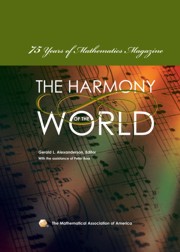Book contents
- Frontmatter
- Introduction
- Contents
- A Brief History of Mathematics Magazine
- Part I The First Fifteen Years
- Perfect Numbers
- Rejected Papers of Three Famous Mathematicians
- Review of Men of Mathematics
- Oslo under the Integral Sign
- Vigeland's Monument to Abel in Oslo
- The History of Mathematics
- Numerical Notations and Their Influence on Mathematics
- Part II The 1940s
- Part III The 1950s
- Part IV The 1960s
- Part V The 1970s
- Part VI The 1980s
- Briefly Noted
- The Problem Section
- Index
- About the Editors
Review of Men of Mathematics
from Part I - The First Fifteen Years
- Frontmatter
- Introduction
- Contents
- A Brief History of Mathematics Magazine
- Part I The First Fifteen Years
- Perfect Numbers
- Rejected Papers of Three Famous Mathematicians
- Review of Men of Mathematics
- Oslo under the Integral Sign
- Vigeland's Monument to Abel in Oslo
- The History of Mathematics
- Numerical Notations and Their Influence on Mathematics
- Part II The 1940s
- Part III The 1950s
- Part IV The 1960s
- Part V The 1970s
- Part VI The 1980s
- Briefly Noted
- The Problem Section
- Index
- About the Editors
Summary
Editors' Note: E. T. Bell's Men of Mathematics is one of the all-time best sellers among books on mathematics or mathematicians. We now recognize that the title appears to exclude the possibility of women being mathematicians. Sonja Kovalevsky, the only woman with a biography in the text, is given only half a chapter. The title was not Bell's, however; it was forced on him by the publishers who wanted a counterpart to their popular Men of Art. In recent years it has become fashionable to “discover” errors in Bell's accounts in Men of Mathematics, a serious problem with the book (see, for example, Tony Rothman: Genius and Biographers: The Fictionalization of Évariste Galois, Amer. Math. Monthly 89 (2) (1982), 84–106).
Readers of Mathematics Magazine at the time Men of Mathematics first appeared, however, would not have been surprised to learn that Bell often made exaggerated statements about his subjects, sometimes seemingly making up the details as he went along. Dunnington would seem to refute that charge, but he clearly alerts readers of the Magazine to the shortcomings in Bell's narrative. He also points out that the book is remarkably entertaining. As Dunnington predicted, the book developed a large and loyal following and it has influenced countless numbers of students and amateurs to become interested in mathematics. The book has not been out of print since its appearance in 1937.
- Type
- Chapter
- Information
- Harmony of the World75 Years of Mathematics Magazine, pp. 9 - 10Publisher: Mathematical Association of AmericaPrint publication year: 2007

